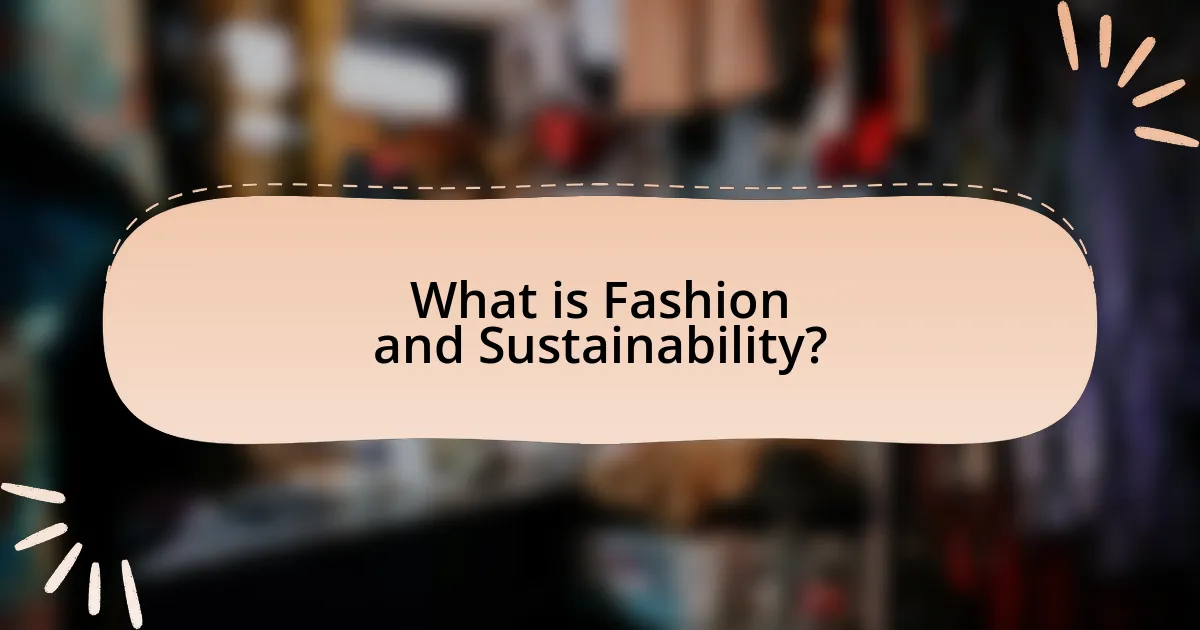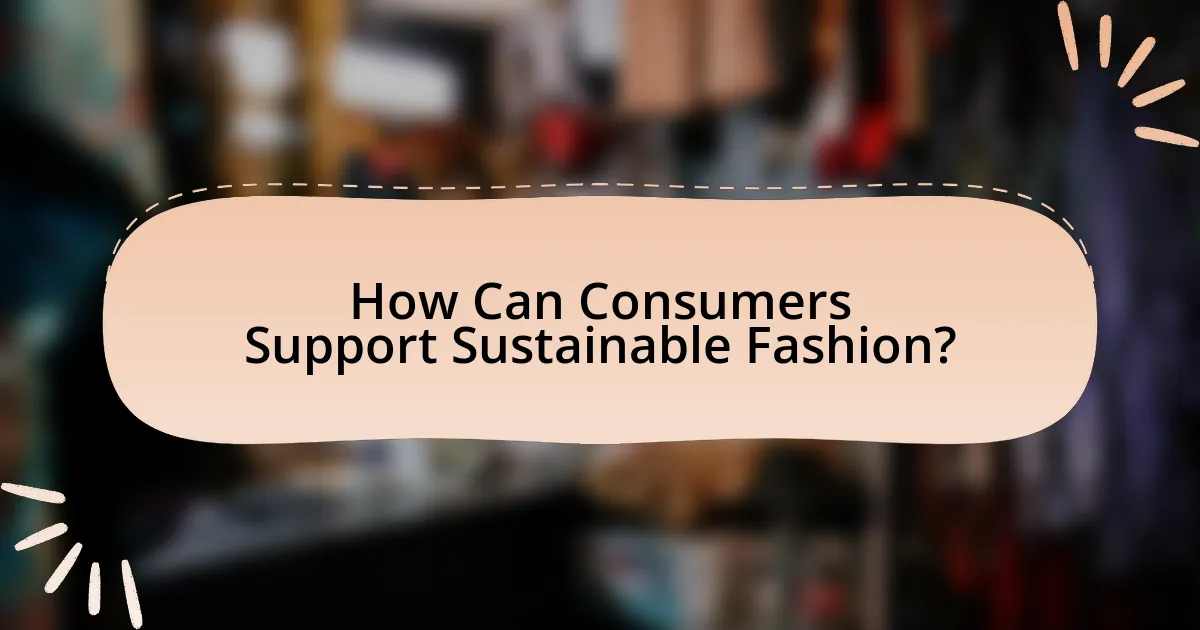Fashion and sustainability encompass the integration of environmentally and socially responsible practices within the fashion industry, aiming to reduce its negative impact on the planet and society. The article explores the intersection of fashion and sustainability, highlighting key principles such as ethical production, resource efficiency, and circularity. It addresses the challenges posed by fast fashion, the environmental consequences of traditional production methods, and the innovations driving ethical practices, including sustainable materials and digital technologies. Additionally, it discusses the role of consumers in supporting sustainable fashion through informed purchasing decisions and the importance of transparency in supply chains.

What is Fashion and Sustainability?
Fashion and sustainability refer to the integration of environmentally and socially responsible practices within the fashion industry. This concept emphasizes reducing the negative impact of clothing production and consumption on the planet and society. For instance, sustainable fashion includes the use of eco-friendly materials, ethical labor practices, and waste reduction strategies. According to the Global Fashion Agenda’s 2021 report, the fashion industry is responsible for 10% of global carbon emissions, highlighting the urgent need for sustainable practices to mitigate environmental damage.
How do fashion and sustainability intersect?
Fashion and sustainability intersect through the adoption of eco-friendly materials and ethical production practices that minimize environmental impact. The fashion industry is one of the largest polluters globally, contributing to significant waste and carbon emissions; for instance, the Ellen MacArthur Foundation reports that the fashion sector is responsible for 10% of global carbon emissions. Sustainable fashion aims to reduce this footprint by utilizing organic fabrics, recycled materials, and implementing circular economy principles, which promote recycling and reusing garments. Additionally, brands are increasingly focusing on fair labor practices, ensuring that workers are treated ethically and compensated fairly, which aligns with the broader goals of sustainability. This intersection not only addresses environmental concerns but also fosters social responsibility within the industry.
What are the key principles of sustainable fashion?
The key principles of sustainable fashion include ethical production, resource efficiency, and circularity. Ethical production emphasizes fair labor practices and humane working conditions, ensuring that workers are treated with respect and compensated fairly. Resource efficiency focuses on minimizing waste and reducing the environmental impact of materials used in fashion, such as opting for organic or recycled fabrics. Circularity promotes the idea of designing products for longevity and recyclability, encouraging consumers to engage in practices like upcycling and responsible disposal. These principles collectively aim to create a fashion industry that prioritizes environmental health and social equity.
Why is sustainability important in the fashion industry?
Sustainability is important in the fashion industry because it addresses environmental degradation, social inequality, and economic viability. The fashion industry is one of the largest polluters globally, contributing to significant waste and carbon emissions; for instance, it accounts for about 10% of global carbon emissions and is responsible for 20% of wastewater. By adopting sustainable practices, such as using eco-friendly materials and ethical labor practices, the industry can reduce its environmental footprint and promote social responsibility. This shift not only benefits the planet and communities but also meets the growing consumer demand for ethical products, as studies show that 66% of consumers are willing to pay more for sustainable brands.
What challenges does the fashion industry face regarding sustainability?
The fashion industry faces significant challenges regarding sustainability, primarily due to its reliance on fast fashion, which promotes overconsumption and waste. Fast fashion brands produce large quantities of low-cost clothing, leading to increased textile waste; in 2018, the global fashion industry generated 92 million tons of waste, according to the Ellen MacArthur Foundation. Additionally, the industry struggles with resource-intensive production processes that deplete water and energy, as it takes approximately 2,700 liters of water to produce a single cotton t-shirt. Furthermore, the lack of transparency in supply chains complicates efforts to ensure ethical labor practices and environmental compliance, making it difficult for consumers to make informed choices. These factors collectively hinder the industry’s ability to adopt sustainable practices effectively.
How does fast fashion impact sustainability efforts?
Fast fashion significantly undermines sustainability efforts by promoting a cycle of overproduction and waste. The fast fashion industry produces approximately 92 million tons of textile waste annually, contributing to environmental degradation and resource depletion. This model encourages consumers to purchase clothing at a rapid pace, leading to increased demand for cheap materials and labor, which often results in poor working conditions and environmental harm. Furthermore, the rapid turnover of trends fosters a culture of disposability, where garments are discarded after minimal use, exacerbating landfill issues and pollution.
What are the environmental consequences of traditional fashion production?
Traditional fashion production has significant environmental consequences, including high water consumption, pollution, and waste generation. The fashion industry is responsible for using approximately 93 billion cubic meters of water annually, which contributes to water scarcity in many regions. Additionally, the production processes often involve toxic chemicals that contaminate water sources, with an estimated 20% of global wastewater coming from textile dyeing and treatment. Furthermore, traditional fashion production generates substantial textile waste, with around 92 million tons of waste produced each year, much of which ends up in landfills. These factors collectively highlight the detrimental impact of conventional fashion practices on the environment.

What Innovations are Driving Ethical Production Practices in Fashion?
Innovations driving ethical production practices in fashion include sustainable materials, digital technologies, and circular economy models. Sustainable materials, such as organic cotton and recycled polyester, reduce environmental impact by minimizing resource consumption and waste. Digital technologies, including 3D printing and blockchain, enhance transparency and traceability in supply chains, allowing consumers to verify ethical practices. Circular economy models promote recycling and upcycling, extending the lifecycle of garments and reducing landfill waste. According to a report by McKinsey & Company, the adoption of these innovations can significantly lower the fashion industry’s carbon footprint, aligning with global sustainability goals.
How are new technologies influencing sustainable fashion production?
New technologies are significantly influencing sustainable fashion production by enabling more efficient resource use and reducing waste. Innovations such as 3D printing allow for precise manufacturing, minimizing material waste, while digital textile printing reduces water consumption compared to traditional dyeing methods. Additionally, blockchain technology enhances transparency in supply chains, allowing consumers to verify the sustainability of their purchases. According to a report by McKinsey & Company, the adoption of these technologies can lead to a reduction of up to 30% in resource consumption in the fashion industry.
What role does 3D printing play in ethical fashion?
3D printing plays a significant role in ethical fashion by enabling sustainable production methods that reduce waste and resource consumption. This technology allows designers to create garments and accessories on-demand, minimizing overproduction and excess inventory, which are major contributors to environmental harm in the fashion industry. For instance, a study by the Ellen MacArthur Foundation highlights that 3D printing can reduce material waste by up to 90% compared to traditional manufacturing processes. Additionally, 3D printing facilitates the use of eco-friendly materials, such as biodegradable plastics, further aligning with ethical fashion principles.
How can blockchain technology enhance transparency in the supply chain?
Blockchain technology enhances transparency in the supply chain by providing an immutable ledger that records every transaction and movement of goods. This technology allows all participants in the supply chain, including manufacturers, suppliers, and consumers, to access real-time data about product origins, processing, and distribution. For instance, a study by Accenture found that 83% of supply chain executives believe blockchain can improve transparency and traceability, which is crucial for ethical production practices in the fashion industry. By enabling traceability, blockchain helps verify claims about sustainability and ethical sourcing, thereby fostering trust among consumers and stakeholders.
What are some examples of brands leading in sustainable practices?
Patagonia, Stella McCartney, and Eileen Fisher are examples of brands leading in sustainable practices. Patagonia is known for its commitment to environmental activism and uses recycled materials in its products, with over 69% of its materials sourced sustainably. Stella McCartney emphasizes cruelty-free fashion and has pioneered the use of innovative, sustainable materials like vegan leather. Eileen Fisher focuses on ethical labor practices and has implemented a take-back program to recycle old garments, aiming for a circular economy. These brands exemplify leadership in sustainability within the fashion industry through their innovative approaches and commitment to ethical production.
How do these brands implement ethical sourcing and production?
Brands implement ethical sourcing and production by establishing transparent supply chains, ensuring fair labor practices, and utilizing sustainable materials. For instance, companies like Patagonia and Everlane disclose their sourcing processes, allowing consumers to trace the origins of their products. They also adhere to fair trade standards, which guarantee that workers receive fair wages and work in safe conditions. Additionally, many brands are shifting towards organic and recycled materials, reducing environmental impact; for example, H&M’s Conscious Collection uses organic cotton and recycled polyester. These practices not only promote sustainability but also enhance brand credibility and consumer trust.
What impact do these brands have on consumer behavior?
Brands focused on sustainability significantly influence consumer behavior by increasing awareness and preference for ethical products. Research indicates that consumers are more likely to purchase from brands that demonstrate commitment to sustainable practices, with 66% of global consumers willing to pay more for sustainable brands, according to a Nielsen report. This shift in consumer behavior is driven by a growing concern for environmental issues and social responsibility, leading to increased demand for transparency in production processes. Consequently, brands that prioritize ethical production not only attract environmentally conscious consumers but also foster brand loyalty and advocacy among their customer base.

How Can Consumers Support Sustainable Fashion?
Consumers can support sustainable fashion by choosing to purchase from brands that prioritize ethical production practices and environmentally friendly materials. By selecting clothing made from organic cotton, recycled fabrics, or sustainable fibers like Tencel, consumers directly contribute to reducing the environmental impact of the fashion industry. According to a 2021 report by the Global Fashion Agenda, sustainable fashion can reduce greenhouse gas emissions by up to 30% if consumers shift their purchasing habits towards eco-friendly brands. Additionally, consumers can extend the lifecycle of their clothing by opting for second-hand purchases, participating in clothing swaps, or donating items, which helps minimize waste.
What are the best practices for consumers to adopt sustainable fashion choices?
Consumers can adopt sustainable fashion choices by prioritizing quality over quantity, opting for eco-friendly materials, and supporting ethical brands. Prioritizing quality ensures that clothing lasts longer, reducing the frequency of purchases and waste. Eco-friendly materials, such as organic cotton or recycled fabrics, minimize environmental impact during production. Supporting ethical brands that practice fair labor and sustainable sourcing contributes to a more responsible fashion industry. According to a 2021 report by the Global Fashion Agenda, sustainable practices can significantly reduce the fashion industry’s carbon footprint, highlighting the importance of consumer choices in driving change.
How can consumers identify truly sustainable brands?
Consumers can identify truly sustainable brands by examining their transparency, certifications, and supply chain practices. Brands that openly share information about their sourcing, production processes, and environmental impact demonstrate a commitment to sustainability. Certifications such as Fair Trade, GOTS (Global Organic Textile Standard), and B Corp indicate adherence to rigorous sustainability standards. Additionally, brands that prioritize ethical labor practices and use eco-friendly materials, such as organic cotton or recycled fibers, further validate their sustainability claims. Research shows that companies with transparent supply chains and third-party certifications are more likely to engage in sustainable practices, making it easier for consumers to make informed choices.
What role does second-hand shopping play in sustainability?
Second-hand shopping significantly contributes to sustainability by reducing waste and minimizing the demand for new production. By purchasing used items, consumers extend the lifecycle of products, which decreases the volume of textiles that end up in landfills; in fact, the Ellen MacArthur Foundation reports that the fashion industry generates over 92 million tons of waste annually. Additionally, second-hand shopping lessens the environmental impact associated with manufacturing new clothing, which often involves resource-intensive processes such as water consumption and carbon emissions. Thus, engaging in second-hand shopping not only promotes a circular economy but also supports sustainable practices within the fashion industry.
What are the future trends in fashion sustainability?
Future trends in fashion sustainability include the increased use of circular economy principles, innovative materials, and transparency in supply chains. Circular economy practices focus on designing products for longevity, repairability, and recyclability, reducing waste significantly. For instance, brands like Stella McCartney are pioneering the use of biodegradable materials and closed-loop systems. Additionally, advancements in technology, such as blockchain, enhance supply chain transparency, allowing consumers to trace the origins of their garments, which is increasingly demanded by eco-conscious shoppers. According to a McKinsey report, 67% of consumers consider sustainability when making a purchase, indicating a strong market shift towards sustainable practices.
How might consumer preferences shape the future of sustainable fashion?
Consumer preferences will significantly shape the future of sustainable fashion by driving demand for eco-friendly materials and ethical production practices. As consumers increasingly prioritize sustainability, brands are compelled to adopt practices that align with these values, such as using organic fabrics and ensuring fair labor conditions. A 2021 survey by McKinsey & Company found that 67% of consumers consider the use of sustainable materials important when making fashion purchases, indicating a clear shift towards environmentally conscious buying behavior. This trend encourages brands to innovate in their supply chains and product offerings, ultimately leading to a more sustainable fashion industry.
What innovations are on the horizon for ethical production practices?
Innovations on the horizon for ethical production practices include advancements in sustainable materials, such as bio-fabricated textiles and recycled fibers, which significantly reduce environmental impact. For instance, companies are increasingly utilizing mycelium and algae to create biodegradable fabrics, which can replace conventional materials like leather and polyester. Additionally, blockchain technology is being integrated into supply chains to enhance transparency and traceability, allowing consumers to verify the ethical sourcing of materials. Research indicates that the global market for sustainable fashion is projected to reach $8.25 billion by 2023, reflecting a growing demand for ethical practices in the industry.
What practical steps can individuals take to promote sustainability in fashion?
Individuals can promote sustainability in fashion by adopting practices such as buying second-hand clothing, choosing sustainable brands, and reducing consumption. Purchasing second-hand clothing extends the lifecycle of garments, thereby minimizing waste; studies show that the fashion industry contributes to 92 million tons of waste annually. Opting for sustainable brands that prioritize eco-friendly materials and ethical labor practices supports responsible production methods. Additionally, reducing consumption by embracing minimalist wardrobes or capsule collections can significantly decrease the environmental impact associated with fast fashion, which is responsible for 10% of global carbon emissions.




